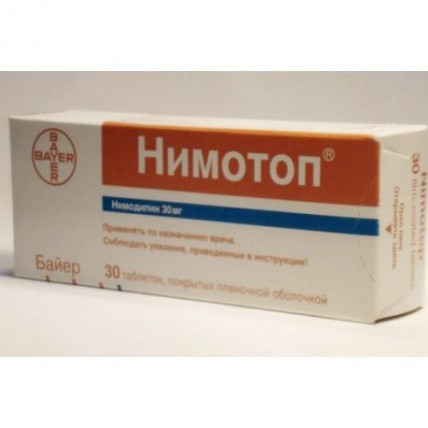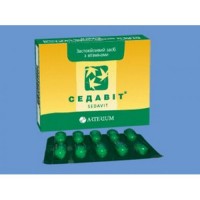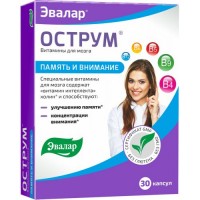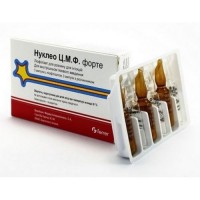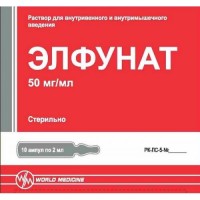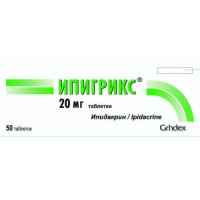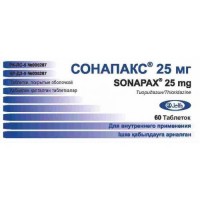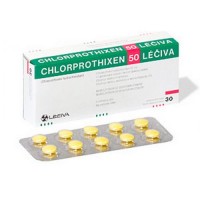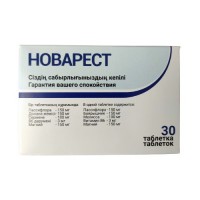Nimotop 30s 30 mg coated tablets
- $36.20
Out Of Stock
The instruction for medical use of Nimotop® medicine the Trade name of Nimotop® the International unlicensed name Nimodipin Lekarstvennaya the Tablet form, film coated, 30 mg Structure One tablet contains active agent - nimodipin 30 mg, excipients: a kernel - corn starch, cellulose microcrystalline, povidone, krospovidon, magnesium stearate structure of a cover: a gipromelloza 15 sr, ferrous oxide yellow (E172), the titan dioxide (E171), a macrogoal 4000 (polyethyleneglycol) the Description of the Tablet, film coated yellow color, round shape, with a biconvex surface, with an engraving of SK on one party and a signature bayerovsky cross – on another. Pharmacotherapeutic group Drugs for treatment of diseases of a cardiovascular system. Blockers of slow calcium channels. Blockers of slow calcium channels selection. Dihydropyridinic derivatives. Nimodipin the ATX C08CA06 Code the Pharmacological Pharmacokinetics Absorption Later properties of intake active agent nimodipin is almost completely soaked up. In 10-15 min. after reception of a tablet, not changed active agent and products of metabolism of the first passing are defined in blood plasma. At elderly people after repeated oral administration (30 mg 3 times a day) average maximum concentration in blood plasma (Smaks) make 7.3-43.2 ng/ml and are reached in 0.6-1.6 h (tmaks). Patients of young age after a single dose have 30 mg or 60 mg average maximum concentration in blood plasma make 16±8 ng/ml and 31±12 ng/ml, respectively. Increase in the maximum concentration in blood plasma and the area under a curve concentration time (AUC) has dose-dependent character to the maximum studied dose of 90 mg). Linking with proteins of plasma and Nimodipin's distribution to 97-99% contacts proteins of blood plasma. Nimodipin gets through a placental barrier in the researches in Vivo. Despite the absence of data, at people it is possible to assume penetration of drug through a placental barrier too. In the researches in Vivo in milk authentically higher came to light, than in plasma, concentration of a nimodipin and/or its metabolites. In breast milk of women nimodipin was defined in the concentration comparable to concentration in blood plasma. Nimodipin can be defined in cerebrospinal fluid in the concentration making about 0.5% of concentration in blood plasma that in general is equivalent to concentration of free substance in blood plasma. Nimodipin is brought in the metabolic way with participation of enzymes of a system of P450 3A4 cytochrome, mainly, by dehydrogenation of a dihydropyridinic ring and oxidizing splitting of ether. Oksilitelny splitting of ether, hydroxylation of 2- and 6-methyl groups and a glyukuronization as conjugation test, are additional important stages of metabolism. Three main metabolites defined in blood plasma do not possess, or have insignificant residual therapeutic activity. Existence of the inducing or inhibiting influence on enzymes of a liver is not known. At people the metabolites are removed with a speed about 50% through kidneys and about 30% with bile. Elimination kinetics linear. Elimination half-life of a nimodipin is in limits 1.1-1.7 hours. Terminal elimination half-life, equal 5-10 hours, does not represent the importance in respect of influence on a dosing interval. An average progression of concentration of a nimodipin in plasma after intravenous infusion of 0.015 mg/kg within one hour (n=24, older persons). Bioavailability Due to the high speed of metabolism at the first passing through a liver (85-95%), the absolute bioavailability of a nimodipin is 5-15%. The pharmacodynamics Nimodipin is an antagonist of calcium channels of 1.4-dihydropyridinic group. Due to high lipophilicity active agent well gets through a blood-brain barrier. During preclinical trials it was established what nimodipin, being high-affine and selection to calcium channels of L-type, thus, blocks transmembrane intake of calcium in cells. At the morbid conditions connected with the increased receipt of calcium ions in neurons, for example, in brain ischemia, assume what nimodipin improves their stability and functioning. Ischemic neurologic disturbances and mortality at patients with subarachnoidal hemorrhage at use of a nimodipin considerably decrease. Indications - prevention and treatment of the ischemic neurologic disorders caused by a brain angiospasm against the background of subarachnoidal hemorrhage owing to a rupture of aneurysm (it is applied after the previous intravenous therapy by Nimotop® infusion solution) the Route of administration and doses Oral administration of the tablets Nimotop® on 2 tablets of 6 times a day (6 x 60 mg of a nimodipin) is recommended after the termination of a course of infusional therapy lasting 5-14 days. At patients with undesirable effects the dose of drug can be reduced or treatment can be stopped. Dose adjustment at the combined use with the drugs inhibiting or inducing the system of P450 3A4 cytochrome can be required. Patients with a liver failure At patients with a heavy liver failure, in particular with cirrhosis, the bioavailability of a nimodipin can be increased due to decrease in effect of the first passing and decrease in metabolic clearance. And also undesirable effects, such as hypotension, this category of patients can have more expressed effects. In such cases it is necessary to lower a dose or, if necessary, to consider a question of the therapy termination. Children's and teenage age Safety and efficiency of use of Nimotopa® for children and teenagers aged up to 18 years is not established. Use duration After the termination of a course of infusional therapy, during the next 7 days is recommended oral administration of the tablets Nimotop® in a dose of 60 mg x 6 times a day at an interval of the 4th hour. Tablets should be swallowed entirely, washing down with enough liquid (it is preferable 1 glass of water), irrespective of meal. Intervals between receptions have to make not less than 4 hours. It is necessary to avoid intake of grapefruit juice. Side effects are provided Further the undesirable effects observed in clinical trials (placebo - controlled researches: nimodipin n=703, n=692 placebo, uncontrollable researches: nimodipin n=24964, date 31.08.2005) CIOMS III frequencies are categorized. Within each group of frequency the undesirable effects are distributed as decrease in gravity. Infrequently (& gt, 1/1000 and & lt, 1/100) - thrombocytopenia - allergic reactions, rash - a headache - tachycardia - arterial hypotension, a vazodilatation - nausea Seldom (& gt, 1/10000 and & lt, 1/1000) - bradycardia - intestinal impassability - tranzitorny increase in level of liver enzymes - reactions on the place of an injection and infusion, thrombophlebitis in the place of infusion of the Contraindication - hypersensitivity to a nimodipin or auxiliary components of drug - combined use with rifampicin as the efficiency of Nimotopa® can be considerably reduced - children's age up to 18 years (the efficiency and safety is not established) - combined use with antiepileptic drugs (fenobar bitat, Phenytoinum, carbamazepine) as the efficiency of Nimotopa® can be considerably reduced. Medicinal interactions Fluoxetine the Combined use of a nimodipin and antidepressant of fluoxetine is followed by increase in a kontsetration of a nimodipin in blood plasma for 50%, at the same time concentration of fluoxetine considerably decreases, and concentration of its active metabolite of a norfluoksetin does not change. Nortriptilin leads Simultaneous use of a nimodipin and nortriptilin to small decrease in exposure of a nimodipin in an equilibrium state without change of concentration of a nortriptilin in blood plasma. Nimodipin is metabolized with participation of the system of P450 3A4 cytochrome which is localized in mucous intestines and in a liver. Medicines which inhibit or induce this fermental system, can influence primary passage or clearance of a nimodipin, therefore. At joint purpose of a nimodipin with the following medicines it is necessary to consider degree and duration of interactions: Rifampicin As a matter of experience of use of other antagonists of calcium is expected that rifampicin accelerates metabolic splitting of a nimodipin by means of induction of activity of enzymes and, in fact, considerably to reduce efficiency of a nimodipin at their simultaneous use. Therefore combined use of Nimotopa® and rifampicin contraindicated. The antiepileptic medicines inducing activity of enzymes of a system of P450 3A4 cytochrome, such as phenobarbital, Phenytoinum or carbamazepine the Previous prolonged use of such antiepileptic drugs as phenobarbital, Phenytoinum or carbamazepine considerably reduces bioavailability of a nimodipin at intake. Therefore, simultaneous performing oral therapy nimodipiny and these anticonvulsant drugs contraindicated. At simultaneous use of a nimodipin and the following inhibitors of a system of P450 3A4 cytochrome it is necessary to control arterial blood pressure and if necessary to korrigirovat a dose of Nimotopa®: Makrolidny antibiotics (for example, erythromycin) Issledovany on studying interactions between Nimotopom® and makrolidny antibiotics it was not carried out. Some makrolidny antibiotics are capable to inhibit the system of P450 3A4 cytochrome. Now it is impossible to exclude the probability of medicinal interactions. Therefore, makrolidny antibiotics should not be used along with Nimotopom®. Azithromycin does not inhibit CYP enzyme 3A4, though belongs on structure to makrolidny antibiotics. HIV protease inhibitors (for example, ritonavir) Issledovany for the purpose of establishment of possible interaction of Nimotopa® and inhibitors of HIV protease it was not carried out. It is reported that drugs of this class have ability to inhibit the system of P450 3A4 cytochrome. Therefore, at their simultaneous use with Nimotopom® the possibility of the significant and clinically significant increase in concentration of a nimodipin in blood plasma is not excluded. Antifungal drugs of azolovy type (for example, ketokonazol) Issledovany for the purpose of establishment of possible interaction of a nimodipin and a ketokonazol it was not carried out. Antifungal drugs of azolovy type, as we know, inhibit the system of P450 3A4 cytochrome. Concerning other antagonists of calcium of digidpropiridinovy type it was reported about various interactions. Therefore, at their combined use with Nimotopom® for intake the possibility of significant increase in system bioavailability of a nimodipin in blood plasma owing to decrease in primary metabolism in a liver is not excluded. Nefazodon Issledovany for the purpose of assessment of possible medicinal interaction between nimodipiny and nefazodony it was not carried out, nevertheless, it is known that antidepressant effectively inhibits the system of P450 3A4 cytochrome. Therefore, at combined use with nefazodony it is impossible to exclude the probability of increase in plasma concentration of a nimodipin. Hinupristin / dalfopristin As a matter of experience can lead uses of the antagonist of calcium of nifedipine, joint appointment with hinupristinom/dalfopristiny to increase in concentration of a nimodipin in blood plasma. Cimetidinum Cimetidinum can lead Simultaneous use with H2 antagonist to increase in concentration of a nimodipin in blood plasma. Valproic acid valproic acid can lead the Combined use with anticonvulsant drug to increase in concentration of a nimodipin in blood plasma. Other medicinal interactions Antihypertensive drugs In a combination with the following drugs reducing arterial blood pressure, Nimotop® can enhance hypotensive effect: • diuretics • beta blockers • inhibitors of angiotensin-converting enzyme • blockers of receptors of angiotensin 1 • other antagonists of calcium • alpha adrenoblockers • phosphodiesterase 5 inhibitors • alpha Methyldopum However if purpose of a combination with one of the specified drugs inevitably, then it is necessary to control a condition of the patient carefully. The zidovudine leads Simultaneous intravenous jet administration of a nimodipin and zidovudine in preclinical trials to significant increase in plasma levels (to the area under a curve concentration time) a zidovudine and to considerable decrease in volume of its distribution and clearance. Simultaneous therapy by potentially nephrotoxic drugs (for example, aminoglycosides, cephalosporins, furosemide), and also at patients with a renal failure, can worsen function of kidneys. In such cases the careful control of function of kidneys is shown. At deterioration in function of kidneys it is necessary to consider the treatment termination. Grapefruit juice the System of P450 3A4 cytochrome is inhibited by grapefruit juice. At simultaneous introduction of the antagonist of calcium of digidpropiridinovy type and intake of grapefruit juice the plasma concentration of a nimodipin increase, and duration of action is extended owing to decrease in metabolism of the first passing or the slowed-down excretion. As a result the antihypertensive effect can amplify. Such action can continue within at least 4 days after the last intake of grapefruit juice. Therefore against the background of treatment nimodipiny consumption of grapefruits or grapefruit juice should be avoided. In spite of the fact that at treatment of Nimotopom® the increase in intracranial pressure is not observed, careful monitoring in such cases and also when water content in tissues of a brain is increased (is recommended to carry out special instructions in generalized wet brain). Нимотоп® appoint with care at patients with arterial hypotension (systolic pressure is lower than 100 mm Hg). At patients with unstable stenocardia or within the first 4 weeks after the postponed acute myocardial infarction it is necessary to consider potential risk (such as decrease in perfusion of coronary arteries and ischemia of a myocardium) in relation to advantage (for example, improvement of perfusion of vessels of a brain). As nimodipin it is metabolized with participation of a system of P450 3A4 cytochrome, the medicines inhibiting or inducing this fermental system can influence primary passage or removal of a nimodipin. To medicines, the enzymes of a system of P450 3A4 cytochrome inhibiting activity promoting increase in concentration of a nimodipin in blood plasma, for example, belong: - makrolidny antibiotics (for example, erythromycin) - HIV protease inhibitors (for example, ritonavir) - azolovy antifungal means (for example, ketokonazol) - antidepressants nefazodon and fluoxetine - hinupristin/dalfopristin - Cimetidinum - valproic acid At joint appointment with the specified drugs it is necessary to control arterial blood pressure, and if necessary to lower a dose of Nimotopa®. Pregnancy and the period of a lactation Appropriate and controlled researches at women during pregnancy were not conducted. Before use of drug during pregnancy it is necessary to weigh advantage and potential risk of administration of drug depending on weight of a clinical picture. Nimodipin and his metabolites get into breast milk in the concentration similar to concentration in mother's plasma. Therefore the woman should stop feeding by a breast during treatment. Fertility In some cases of in vitro fertilization reception of antagonists of calcium was connected with development of reversible biochemical changes of a head of the spermatozoa able to lead to sperm decline in quality. It is unknown in what degree this observation is significant for a short-term course of treatment. Use in pediatrics Safety and efficiency of Nimotopa® at children and teenagers is younger than 18 years is not proved. Due to the insufficient experience of use for children and teenagers, nimodipin it is not intended for treatment of this age group of patients. Features of influence of medicine on ability to run the vehicle and potentially dangerous mechanisms Drug affects ability of control of vehicles or potentially dangerous mechanisms in connection with vozmozh
ym dizziness. During driving by motor transport or work with mechanisms reaction can slow down. Overdose Symptoms: as a result of acute overdose the considerable lowering of arterial pressure, tachycardia or bradycardia and also gastrointestinal disturbances, including nausea is expected. Treatment: use of Nimotopa® needs to be stopped immediately, urgent measures are defined by symptoms. As first aid it is necessary to consider gastric lavage and intake of activated carbon. In a considerable lowering of arterial pressure it is necessary to enter intravenously a dopamine or noradrenaline. Due to the lack of specific antidote the subsequent treatment should be carried out concerning the prevailing symptoms. A form of release and packing On 10 tablets in blister strip packaging from aluminum foil and a film of software or PVH/PVDH. On 3 or 10 blister strip packagings together with the instruction for medical use in the state and Russian languages place in a pack from cardboard. To Store storage conditions at a temperature not above 30 °C, in the dry, protected from light place. To store out of children's reach! Not to apply a period of storage of 5 years after an expiration date. Prescription status According to the prescription of Proizvoditel Bayer AG, Leverkusen, Germany. Owner of the registration certificate of Bayer AG, Leverkusen, Germany. The address of the organization accepting in the territory of the Republic of Kazakhstan claims from consumers on quality of medicine TOO Bayer KAZ Timiryazev St., 42, pavilion 15, office 301 050057 of Almaty, the Republic of Kazakhstan, ph. +7 727 258 80 40, fax: +7 727 258 80 39 e-mail: kz.claims@bayer.com the Address of the organization in the territory of the Republic of Kazakhstan responsible for post-registration observation of safety of medicine. TOO Bayer KAZ Timiryazev St., 42, pavilion 15, office 301 050057 of Almaty, Republic of Kazakhstan, ph. +7 701 715 78 46 (round the clock) ph. +7 727 258 80 40, vn. 106 (in working hours) fax: +7 727 2588 039
To develop
ym dizziness. During driving by motor transport or work with mechanisms reaction can slow down. Overdose Symptoms: as a result of acute overdose the considerable lowering of arterial pressure, tachycardia or bradycardia and also gastrointestinal disturbances, including nausea is expected. Treatment: use of Nimotopa® needs to be stopped immediately, urgent measures are defined by symptoms. As first aid it is necessary to consider gastric lavage and intake of activated carbon. In a considerable lowering of arterial pressure it is necessary to enter intravenously a dopamine or noradrenaline. Due to the lack of specific antidote the subsequent treatment should be carried out concerning the prevailing symptoms. A form of release and packing On 10 tablets in blister strip packaging from aluminum foil and a film of software or PVH/PVDH. On 3 or 10 blister strip packagings together with the instruction for medical use in the state and Russian languages place in a pack from cardboard. To Store storage conditions at a temperature not above 30 °C, in the dry, protected from light place. To store out of children's reach! Not to apply a period of storage of 5 years after an expiration date. Prescription status According to the prescription of Proizvoditel Bayer AG, Leverkusen, Germany. Owner of the registration certificate of Bayer AG, Leverkusen, Germany. The address of the organization accepting in the territory of the Republic of Kazakhstan claims from consumers on quality of medicine TOO Bayer KAZ Timiryazev St., 42, pavilion 15, office 301 050057 of Almaty, the Republic of Kazakhstan, ph. +7 727 258 80 40, fax: +7 727 258 80 39 e-mail: kz.claims@bayer.com the Address of the organization in the territory of the Republic of Kazakhstan responsible for post-registration observation of safety of medicine. TOO Bayer KAZ Timiryazev St., 42, pavilion 15, office 301 050057 of Almaty, Republic of Kazakhstan, ph. +7 701 715 78 46 (round the clock) ph. +7 727 258 80 40, vn. 106 (in working hours) fax: +7 727 2588 039
To develop
